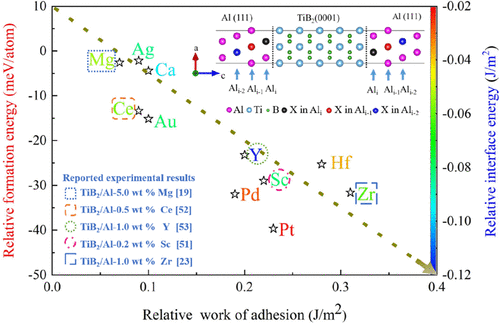当前位置:
X-MOL 学术
›
J. Phys. Chem. C
›
论文详情
Our official English website, www.x-mol.net, welcomes your
feedback! (Note: you will need to create a separate account there.)
Interface Alloying Design to Improve the Dispersion of TiB2 Nanoparticles in Al Composites: A First-Principles Study
The Journal of Physical Chemistry C ( IF 3.3 ) Pub Date : 2021-03-04 , DOI: 10.1021/acs.jpcc.1c00371 Qian Wang 1, 2 , Yuanyuan Li 1, 2 , Siyi Chen 1, 2 , Xiaomin Liu 2 , Zhe Chen 2 , Mingliang Wang 1 , Hong Zhu 2, 3 , Haowei Wang 1, 2
The Journal of Physical Chemistry C ( IF 3.3 ) Pub Date : 2021-03-04 , DOI: 10.1021/acs.jpcc.1c00371 Qian Wang 1, 2 , Yuanyuan Li 1, 2 , Siyi Chen 1, 2 , Xiaomin Liu 2 , Zhe Chen 2 , Mingliang Wang 1 , Hong Zhu 2, 3 , Haowei Wang 1, 2
Affiliation

|
An extensive first-principles database of alloying behavior of 37 elements in the Al(111)/TiB2(0001) interface is presented. The interfacial ability is systematically compared via the formation energy, interface energy, and work of adhesion. The thermodynamically most stable interface with the Ti terminal and center stacking sequence is selected to analyze the alloying behavior. According to the interfacial stability and wettability, an alloying trend map containing 11 excellent elements (Mg, Ca, Ag, Ce, Au, Pd, Y, Sc, Pt, Hf, and Zr) is obtained. These elements can effectively improve the dispersion of TiB2 particles in Al-based composites by promoting the formation of the Al/TiB2 interface and improving the interfacial wettability. Based on the number of valence electrons in the d orbital, these alloying elements can be divided into zero-d (Mg and Ca), low-d (Sc, Y, Zr, Ce, and Hf), and high-d (Pd, Ag, Pt, and Au) elements. In combination with the electronic structure of the alloying interfaces, the alloying mechanisms are discussed depending on the hybridization between Al and alloying atoms. Generally, our calculation guides the interface alloying strategy to enhance the particle dispersion in the metal matrix composite and provides a fundamental explanation for the related interfacial mechanisms.
中文翻译:

界面合金化设计,以改善TiB 2纳米粒子在铝复合材料中的分散性:第一性原理研究
提出了一个广泛的第一性原理数据库,其中显示了Al(111)/ TiB 2(0001)界面中37种元素的合金化行为。通过形成能,界面能和粘附功来系统地比较界面能力。选择具有Ti末端和中心堆积顺序的热力学最稳定的界面来分析合金化行为。根据界面稳定性和润湿性,获得了包含11种优良元素(Mg,Ca,Ag,Ce,Au,Pd,Y,Sc,Pt,Hf和Zr)的合金化趋势图。这些元素可通过促进Al / TiB 2的形成而有效地改善TiB 2颗粒在Al基复合材料中的分散性。界面和改善界面润湿性。根据d轨道上的价电子数,这些合金元素可分为零-d(Mg和Ca),低-d(Sc,Y,Zr,Ce和Hf)和高-d(Pd)。 ,Ag,Pt和Au)元素。结合合金化界面的电子结构,根据Al和合金化原子之间的杂化,讨论了合金化机理。通常,我们的计算指导了界面合金化策略以增强金属基复合材料中的颗粒分散性,并为相关的界面机理提供了基本解释。
更新日期:2021-03-18
中文翻译:

界面合金化设计,以改善TiB 2纳米粒子在铝复合材料中的分散性:第一性原理研究
提出了一个广泛的第一性原理数据库,其中显示了Al(111)/ TiB 2(0001)界面中37种元素的合金化行为。通过形成能,界面能和粘附功来系统地比较界面能力。选择具有Ti末端和中心堆积顺序的热力学最稳定的界面来分析合金化行为。根据界面稳定性和润湿性,获得了包含11种优良元素(Mg,Ca,Ag,Ce,Au,Pd,Y,Sc,Pt,Hf和Zr)的合金化趋势图。这些元素可通过促进Al / TiB 2的形成而有效地改善TiB 2颗粒在Al基复合材料中的分散性。界面和改善界面润湿性。根据d轨道上的价电子数,这些合金元素可分为零-d(Mg和Ca),低-d(Sc,Y,Zr,Ce和Hf)和高-d(Pd)。 ,Ag,Pt和Au)元素。结合合金化界面的电子结构,根据Al和合金化原子之间的杂化,讨论了合金化机理。通常,我们的计算指导了界面合金化策略以增强金属基复合材料中的颗粒分散性,并为相关的界面机理提供了基本解释。











































 京公网安备 11010802027423号
京公网安备 11010802027423号